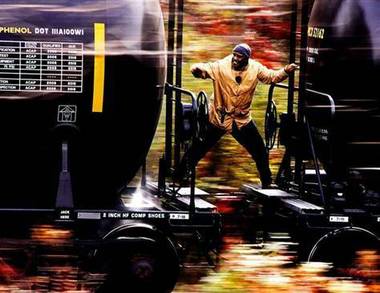This is the third in a series of reviews of spec fic by stealth. The rest are here.
At first glance, Tony Scott’s Unstoppable might appear to be just Speed on a train. But I submit to you that not only is it a much better movie than Speed—Unstoppable is one of the best thrillers I’ve seen in a long time—but that it’s uniquely suited to a science fiction audience. Throughout the film, I found myself comparing it not to Speed, but to Tom Godwin’s legendary science fiction short “The Cold Equations.” Not because Unstoppable revolves around a moral quandary supported by a contrived narrative, but because it sets up its premise and parameters and then follows them ruthlessly to the end.
To wit: a half-mile long freight train weighing in excess of a million pounds and carrying hazardous material is headed for a 15-mph curve in a Harrisberg/Scrantonesque cryptomunicipality in Pennsylvania at 71 miles per hour. Due to human error, the behemoth is unmanned, and the air brakes are not operational.
What do you do?
It seems a bit much, maybe, but the basic premise of the movie is based on a 2001 incident in Ohio, Hollywooded up a little.
We follow the action chiefly from four points of view—that of Barnes (Denzel Washington) a senior engineer on a lesser train that’s on a collision course with the Triple-7 and desperately trying to reach a siding before the runaway reaches it. His conductor is Colson (Chris Pine), a young screwup with too much to prove. The mercurial, hyper-competent station master is Connie (Rosario Dawes), and the old railyard hand who winds up in hot pursuit of the runaway by virtue of being perennially late for for work is Ned (Lew Temple). Between them, these people have a train to catch—and stop, if they can.
There’s no way this isn’t a science fiction premise. It’s all about the intersection of humanity, technology, and the sheer implacability of the laws of physics. This is not a movie about the evils of technology—just the opposite, as every single character in it owes his or her livelihood to the trains. But it is a story about the challenges of managing technology, which is something else again.
Let’s face it: there’s just something about a runaway train. It’s our post-industrial root metaphor for the irresistable force. It’s the largest, most powerful machine that most of us have personal experience with. Trains are awful, in the oldest sense of the word: they inspire awe the same way the opening shot of the Imperial Star Destroyer in Star Wars does.
The Triple-7, the runaway train of the movie’s title, is comparable in size to a Star Destroyer; it’s almost exactly half as long. And it’s shot like a Star Destroyer, or like Kaa in “The Jungle Books”: we never see the whole thing. Its scale is too great; it cannot fit within the limited margins of the screen. It becomes a force of nature, albeit a manufactured one, as it smashes aside obstacles and defeats the best efforts of its puny creators to control, slow, or derail it.
There is no will behind this thing. Only physics. And physics—the very same inescapable physical logic that caused it to run rogue in the first place—is the only way to bring it down.
I say this is stealth science fiction because of that, but also because the narrative abides by its own internal rules—which is more than I can say for most big-screen SF, frankly. The train is on a track: there are only so many places it can go—and only so many immovable objects it can interact with.
The real enjoyability of the movie is watching those limited options play out in a number of almost nauseatingly tense encounters between man and machine.
Elizabeth Bear can hear the trains from where she lives, but only when it’s raining.










